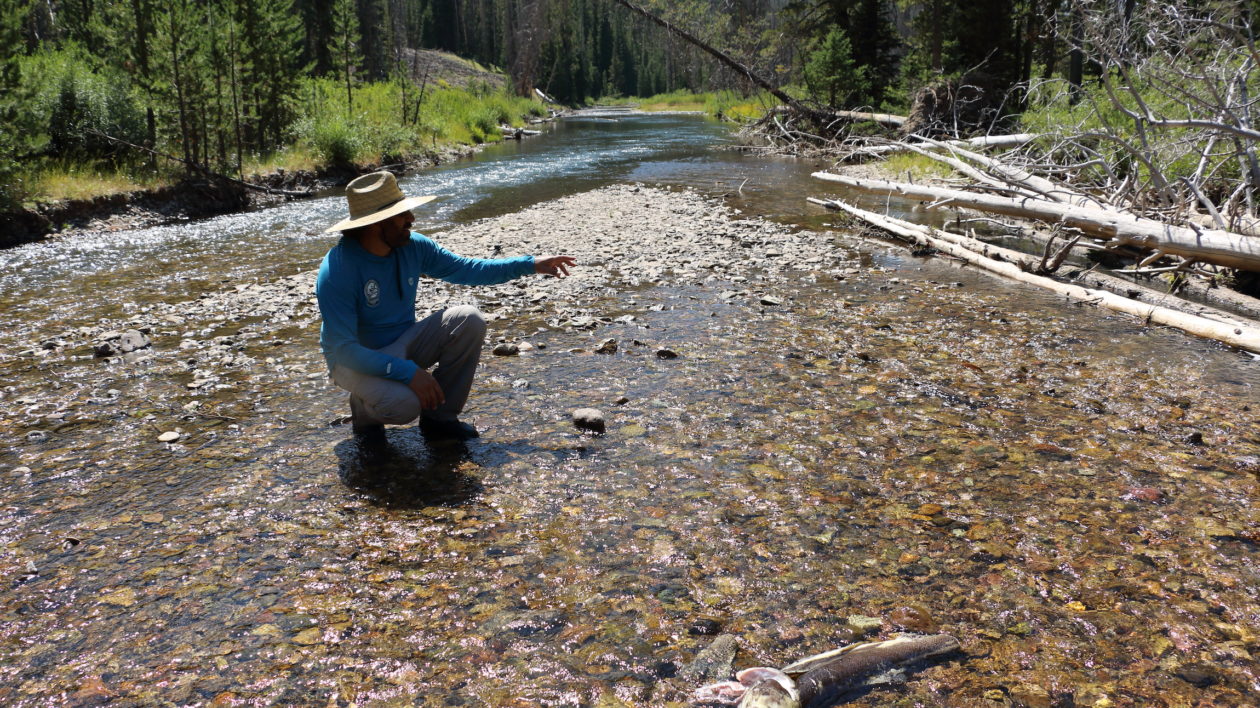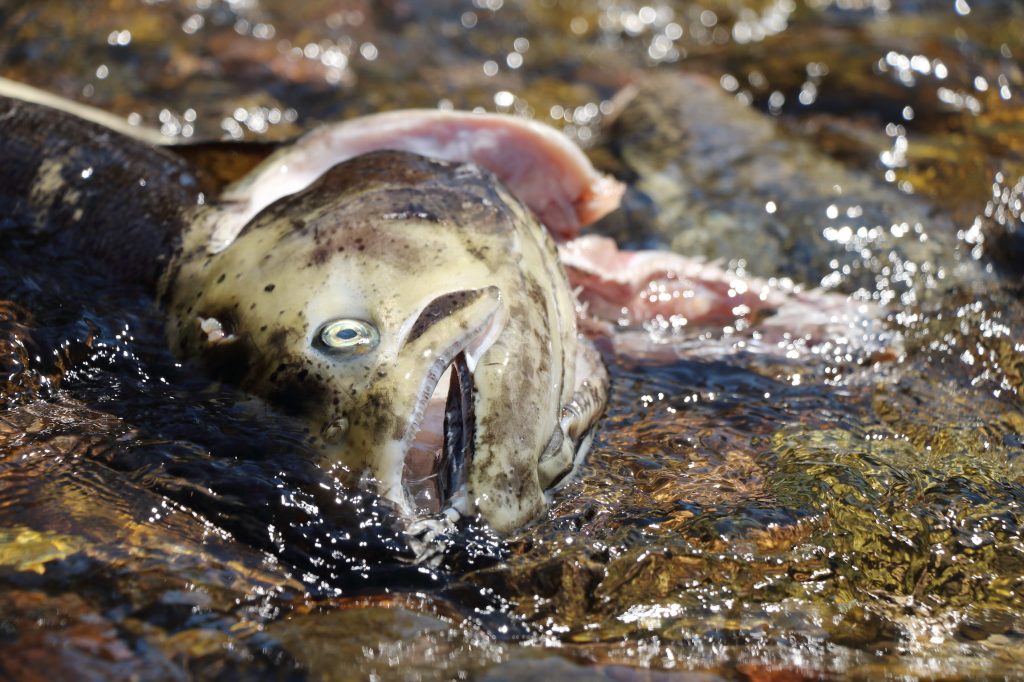Lytle Denny walks with sincere purpose, shaded from the high-elevation sun. His shirt is blue-sky bright. His straw hat, golden honey. He’s a Shoshone-Bannock Tribes fish biologist and he’s heading to an office where a water cooler dominates everyone’s day. It’s the Yankee Fork, a tributary of the Salmon River in central Idaho wilderness that’s barely 15 steps wide.
“In the mid 1980s we started fixing habitat in the Yankee Fork and we’re still doing it,” Denny says. “We’re still trying to improve fish habitat, but by and large the habitat is vacant.”
The vacancy he’s referring to is the void left by Chinook salmon, one of several threatened and endangered fish in the Pacific Northwest. Those fish are food for us and for the forest. Denny is carrying that food, but it’s not his this time. This one belongs to the wild. A spawned and spent Chinook salmon running the length of his leg swings heavy in his right hand. It’s a hatchery fish so it can’t be counted as made by nature. That’s why its tail is missing, a way to identify its origin. Eventually all of it will be missing, the decay of death sprouting new life in this stream 850 miles from the Pacific Ocean. Denny lays the lifeless fish in the stream steps back and watches the dead drift toward a log jam. Bugs zoom in with haste, flies feasting on foul meat within a minute.
“The beautiful thing about salmon is they were really meant to feed the masses,” Denny says. “Their return to these systems is important for driving the food web. We bring these carcasses back to stimulate the process these ecosystems have been deprived of.”
When Chinook salmon returned by the thousands a century ago, their salty, ocean-grown carcasses naturally added nitrogen and other needed elements to landlocked freshwater forests. Now, only a few dozen fish make it this far. Denny is trying to make up for the loss by putting dead hatchery fish in the river.
“Because of limitations on natural or wild salmon, we’ve worked out an agreement with the state to get [salmon] carcasses from a nearby hatchery,” Denny says. “We distribute those carcasses throughout the known spawning areas of Chinook salmon in the Yankee Fork. The end goal is improving the food web and the levels of nitrogen and phosphorous that are limited in this ecosystem.”

Those limitations are revealed in the correlation between fish fins and tree rings. Forest ecologist Tom Reimchen studied nutrient load in old-growth trees for University of Victoria in British Columbia. He says up to 80 percent of the tree growth around rivers containing salmon comes from ocean-originated nitrogen. That marine-marked nutrient comes inland with the fish. If no ocean-raised fish come in, no ocean-made nitrogen comes in either.
“If you take salmon out of the picture, the forest doesn’t disappear,” Reimchen told KQED. “It is just a completely different place. It’s not as rich.”
Denny decided to take the salmon thread a stitch further with an experiment a few years back. His fisheries crew measured and tagged bull trout in July. Those trout live in tributaries that should host Chinook salmon. Salmon migrating from the ocean to Idaho spawned in August then died.
Denny and crew recaptured the tagged bull trout in October and measured their growth. They did this in four similar streams, but created scenarios that were far from similar. They called it their Dr. Seuss Study because the difference went like this: no fish, fake fish, dead fish, real fish.
The stream with bull trout and no salmon was their growth baseline. The stream with fake fish, a.k.a ground salmon pellets, showed minimal growth when compared to baseline. The stream with dead salmon planted by the tribe showed some growth, but the stream with live salmon spawning and dying showed significant growth. No other scenario, not even dead planter fish, came close.
“There’s nothing like having live fish in a stream,” Denny says. “They’re the best in terms of spreading that food resource out to all the consumers in the watershed. Live fish dig up the gravel and deposit eggs. They also dislodge insects that drift down to other fish needing an opportunity to eat. A dead fish isn’t going to dig anything. It’s just going to lay there. We understand the natural process is the best, but we are not in a situation where we have thousands of fish to rely on.”
Denny watches flies feed on the dead fish he just planted. He knows those flies feed bats and birds. He knows bears and badgers may feed on the fish too. They’ll also carry parts of it from the river to the woods, or spread it even farther when they go to the bathroom. Berries have been known to sprout in bear poop. There’s no reason why fish food can’t spread the same way, as long as there are fish.
“It’s important that this food is out here. Not just for the river, but for the river otter. They need to eat too,” Denny says. “I’ve learned a lot about that by being out here and seeing what eats salmon. The productivity of a watershed is related to carrying capacity and fish have an intimate relationship with the carrying capacity of watersheds.”




Great article, Kris. Now if those returning Salmon could be in the tens of thousands to the Salmon and tributaries. Remove the Dams.